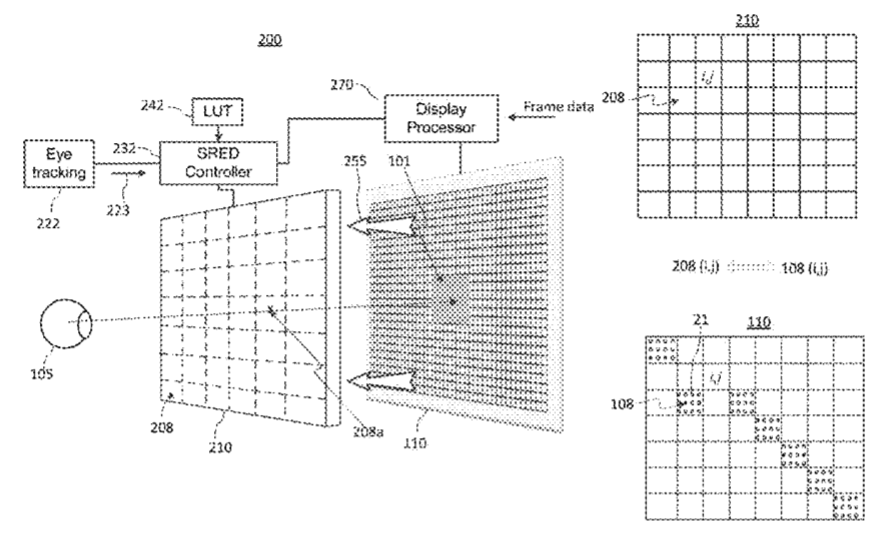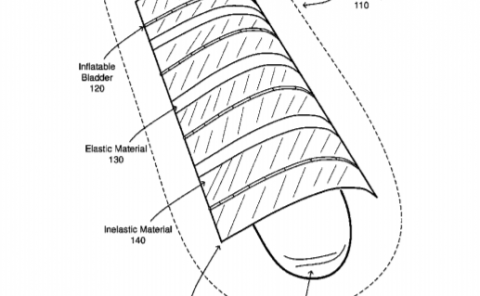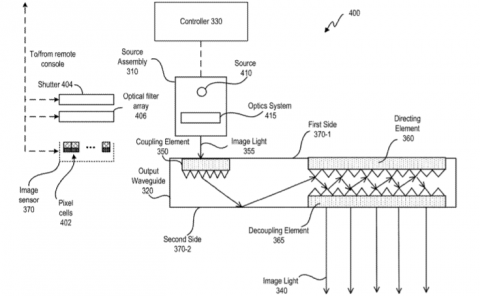Facebook Patent | Display With Gaze-Adaptive Resolution Enhancement
Patent: Display With Gaze-Adaptive Resolution Enhancement
Publication Number: 10636340
Publication Date: 20200428
Applicants: Facebook

Abstract
A display apparatus includes a pixelated display, an eye tracking system, and a segmented resolution enhancing device coupled to the eye tracking system and operable to selectively enhance effective image resolution for the electronic display in the gaze direction. The segmented resolution enhancing device may include a polarization switch in series with a polarization gratings, at least one of which is segmented, for shifting image pixels in the gaze direction between offset positions while displaying a frame.
TECHNICAL FIELD
The present disclosure generally relates to optical display systems and devices, and in particular to head mounted displays (HMDs) and components therefor.
BACKGROUND
HMDs are used to present virtual scenery to a user, or to augment real scenery with virtual information or virtual objects. An HMD typically includes a pixelated electronic display, which displays images by selectively exciting display pixels and/or color sub-pixels to a various degree of luminance. The number of display pixels per unit area, or pixel density, defines a native resolution of the display. Imaging optics may be present that presents the displayed images to the user with magnification, thereby magnifying the display pixels for the user.
Humans with normal visual acuity, typically identified as 20/20 vision, can distinguish two points separated by an angle of one minute of arc (1’), which is the sharpest eyesight observed in the foveola. Within about +/-10.degree. of the foveola, the visual acuity drops to 20/100, which correspond to a resolution angle of 5’. Thus, a typical human eye with the 20/20 sight can resolve two pixels in an image if the light rays they emit enter the eye at an angle to each other as small as 1’. However, the pixel density of an electronic display may be insufficient to directly support the ultimate resolution of a human eye; for example, rays emitted by neighboring pixels of an electronic display used in a typical HDM may enter the eye at an angle greater than 1’, and the user perception of the displayed image may suffer because of that. In addition, some displays have relatively small light emitting areas that are surrounded by interstitial areas from which no light emanates. These interstitial areas are typically dark and may lead to a visual artifact known as screen door when the viewer is able to visually resolve the dark and active areas of the pixels.
BRIEF DESCRIPTION OF THE DRAWINGS
Embodiments disclosed herein will be described in greater detail with reference to the accompanying drawings which represent preferred embodiments thereof, in which like elements are indicated with like reference numerals, and wherein:
FIG. 1A is a schematic isometric view of a liquid crystal (LC) polarization device;
FIG. 1B is a schematic side view of an electrically controlled active LC device;
FIG. 1C is a schematic plan view of an LC Pancharatnam Berry Phase (PBP) grating;
FIG. 1D is a schematic diagram illustrating the operation of an LC PBP grating;
FIG. 2A is a schematic diagram of a 4.times.4 pixel area of a pixel array of an electronic display showing interstitial spaces between pixel active areas;
FIG. 2B is a schematic diagram illustrating an image of the 4.times.4 pixel area of the pixel array of FIG. 2A that may be formed in a display system with magnification and/or active area size correction;
FIG. 3A is a schematic diagram illustrating an eye acuity display system with a gaze-adaptive resolution enhancement for a central gaze direction;
FIG. 3B is a schematic diagram illustrating the eye acuity display system of FIG. 3A with a gaze-adaptive resolution enhancement for a gaze directed to a display periphery;
FIG. 4A is a schematic diagram illustrating a linear array of four adjacent pixels of an electronic display in one pixel row or column;
FIG. 4B is a schematic diagram illustrating increasing effective image pixel density by dynamic image displacement for the linear array of pixels of FIG. 4A;
FIG. 4C is a schematic diagram illustrating the dynamic image displacement of the linear array of pixels of FIG. 4A for defective pixel correction;
FIG. 4D is a schematic diagram illustrating combined resolution enhancement and pixel correction by dynamic image displacement in a 3.times.3 pixel array;
FIG. 5 is a flowchart of a method for gaze-adaptive operation of an electronic display to provide an effective image resolution enhancement for the viewer;
FIG. 6 is a schematic diagram illustrating an embodiment of the eye acuity display system of FIG. 3A with a segmented resolution enhancement device (SRED) for a gaze-adaptive resolution enhancement;
FIG. 7 is a schematic diagram illustrating an example segment array of the SRED of FIG. 6 and corresponding areas of the pixel array of the electronic display;
FIG. 8 is a schematic diagram illustrating local image resolution enhancement in the gaze direction by overlaying two mutually offset images of a portion of the displayed frame;
FIG. 9 is a flowchart of a method for gaze-adaptive operation of an electronic display using a light steering SRED;
FIG. 10 is a schematic diagram illustrating the process of forming subframe images from input image frames in the display system of FIG. 6 according to an embodiment;
FIG. 11 is a schematic diagram of an example HMD, shown in a cross-sectional view, implementing a gaze-adaptive eye-acuity display system;
FIG. 12A is a schematic side view of a one-dimensional (1D) light steering switch formed of a polarization switch followed by a polarization grating;
FIG. 12B is a schematic side view of a one-dimensional (1D) light steering switch formed with a polarization grating followed by a polarization switch;
FIG. 13 is a schematic side view of a 2D light steering switch formed with two rotationally offset polarization gratings in sequence;
FIG. 14 is a schematic diagram of a constellation of image pixels that may be obtained from one display pixels with the 2D light steering switch of FIG. 13;
FIG. 15 is a top view of a segmented active LC device;
FIG. 16 is a schematic isometric view of an example embodiment of a segmented 2D light steering LC switch;
FIG. 17 is a schematic isometric view of another example embodiment of a segmented 2D light steering LC switch;
FIG. 18 is a schematic diagram of an LC PBP gratings with reduced wavelength sensitivity;
FIG. 19 is an isometric view of an example eye-acuity HMD.
DETAILED DESCRIPTION
In the following description, for purposes of explanation and not limitation, specific details are set forth, such as particular optical and electronic circuits, optical and electronic components, techniques, etc. in order to provide a thorough understanding of the present invention. However, it will be apparent to one skilled in the art that the present invention may be practiced in other embodiments that depart from these specific details. In other instances, detailed descriptions of well-known methods, devices, and circuits are omitted so as not to obscure the description of the example embodiments. All statements herein reciting principles, aspects, and embodiments, as well as specific examples thereof, are intended to encompass both structural and functional equivalents thereof. Additionally, it is intended that such equivalents include both currently known equivalents as well as equivalents developed in the future, i.e., any elements developed that perform the same function, regardless of structure.
Note that as used herein, the terms “first”, “second”, and so forth are not intended to imply sequential ordering, but rather are intended to distinguish one element from another, unless explicitly stated. Similarly, sequential ordering of method or process steps does not imply a sequential order of their execution, unless explicitly stated. The terms “frame” and “image frame” are used herein interchangeably and encompass frames carrying image data for a still image and video frames carrying image data for a video.
Furthermore, the following abbreviations and acronyms may be used in the present document:
* HMD Head Mounted Display*
* VR Virtual Reality*
* AR Augmented Reality*
* MR Mixed Reality*
* LC Liquid Crystal*
* LED Light Emitting Diode*
* CP Circular Polarized*
* LCP Left-handed Circular Polarized*
* RCP Right-handed Circular Polarized*
HWP Half-Wave Plate, i.e. a waveplate with a modulo 2.pi. retardance of an odd number of .pi.* radian or an odd number of half-waves*
QWP Quarter-Wave Plate, i.e. a waveplate with a modulo 2.pi. retardance of .pi./2** radian**
nWP n-wave Plate, i.e. a waveplate with a retardance of n.lamda., or an integer number n=0, 1, 2 … of operating wavelengths .lamda.
The present disclosure relates to a method and related systems and devices that may correct for at least some pixelation related artifacts in various display systems, including but not limited to display systems for artificial reality applications such as a head mounted display (HMD) and a near-eye display (NED). The term “artificial reality” relates to a presentation of reality that has been adjusted in some manner. It encompasses a virtual reality (VR), an augmented reality (AR), a mixed reality (MR), a hybrid reality, or some combination and/or derivatives thereof. Pixelation relates to visual artifacts that may appear when the pixelated nature of an image presented by an electronic display becomes noticeable to the user. Pixelation artifacts that may be at least partially compensated by using approaches and techniques described herein include pixel-related limitations on image resolution that may be noticeable to a viewer, which may include limitations related to a display pixel density and the appearance of defective pixels in the image. Here, the term defective pixel relates to pixels that lose the ability to emit light, which may be referred to as “dead pixels”, and pixels that emit less or more light than prescribed by a data signal applied to the pixel. The terms “shift” and “shifting” may encompass positional and angular shifts and positional and angular shifting, respectively.
An aspect of the present disclosure provides an apparatus comprising: an electronic display comprising a pixel array configured to display a frame, the pixel array comprising a plurality of display pixels; an eye tracking device configured to determine a gaze direction of a user of the electronic display; and, an optical block for forming a frame image from the frame displayed by the electronic display, the optical block comprising a segmented resolution enhancing device (SRED) operatively coupled to the eye tracking device, the frame image comprising an array of image pixels disposed at an image pixel pitch p. The SRED may comprise a plurality of device segments configured to be individually activated in response to a signal from the eye tracking device, each device segment being optically coupled to a different group of display pixels of the pixel array, for selectively enhancing effective resolution for a portion of the frame image in the gaze direction.
The apparatus may further comprise a controller configured to activate a selected device segment in the gaze direction from the array of device segments based on the signal from the eye tracking device.
The apparatus may further comprise a display processor configured to provide pixel data to the electronic display for displaying the frame, identify a selected group of display pixels, from the different groups of display pixels of the electronic display, that is optically coupled to the selected device segment, and perform a selective pixel update of the selected group of pixels with new pixel data at least once while the frame is being displayed by the electronic display.
The apparatus of claim 3 wherein the selective pixel update is performed without updating a peripheral group of display pixels located outside of the selected group of display pixels with new pixel data while the frame is being displayed.
In some implementations each device segment may comprise a light steering switch (LSS) configured to switch, upon activation by the controller, between two or more light steering states while the frame is being displayed, so as to provide a sequence of offset images for the portion of the frame image in the gaze direction.
In some implementations the selective pixel update may be performed in coordination with switching the LSS of the selected device segment.
In some implementations the LSS may be operable, upon activation by the controller, to provide the sequence of mutually offset images comprising two images having a spatial offset s therebetween equal to a fraction of the image pixel pitch p.
The frame image may comprise interstitial areas between adjacent image pixels that are at least equal to the image pixels in size, and the spatial offset s may be such that at least some of the image pixels of a first of the two mutually offset images are located in the interstitial spaces of the second of the mutually offset images.
In some implementations the display processor may be configured to selectively sub-sample input frame data for the selected group of display pixels at two or more sampling grids with a sampling offset therebetween matching the spatial offset s.



